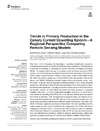Identificador persistente para citar o vincular este elemento:
https://accedacris.ulpgc.es/jspui/handle/10553/24828
| Título: | Trends in primary production in the canary current upwelling system-A regional perspective comparing remote sensing models | Autores/as: | Gómez Letona, Markel Ramos, Antonio G. Aristegui, J. Coca Saenz De Albéniz, Josep |
Clasificación UNESCO: | 2510 Oceanografía 250616 Teledetección (Geología) |
Palabras clave: | Canary current EBUE Upwelling Primary production model Chl-a Decadal trends, et al. |
Fecha de publicación: | 2017 | Publicación seriada: | Frontiers in Marine Science | Resumen: | After Bakun (1990) formulated his hypothesis of upwelling intensification caused by increasing global warming, contradictory results have been published on whether primary productivity is increasing or decreasing in Eastern Boundary Upwelling Ecosystems (EBUE). The present work is focused in comparing three net primary production (NPP) models—the VGPM (Vertically Generalized Production Model), the Eppley-VGPM and the CbPM (Carbon-based Production Model)—in the Canary Current (CanC) EBUE during the 1998–2015 period, making use of both SeaWiFS (Sea-viewing Wide Field-of-view Sensor) and MODIS (MODerate-resolution Imaging Spectroradiometer) derived data. We looked for the first time for seasonal to interannual trends of NPP under a regional perspective, with the aim of searching for temporal patterns that could support or reject the intensification hypothesis. According to previous studies based on the seasonality of the upwelling regime, the CanC EBUE was divided into three subregions: a seasonal upwelling zone (SUZ; 13–20°N), a permanent upwelling zone (PUZ; 20–26°N) and a weak permanent upwelling zone (WPUZ; 26–33°N). Although differences in the output of the models are important, both at regional and subregional scales, our analyses do not show significant increasing trends in NPP with any of the productivity models used. Our results are in accordance with previous published studies that indicate, that unlike other EBUE, winds have weakened (or at least not intensified) in the CanC upwelling over time scales ranging up to 60 years. Nevertheless, the comparison made in this work shows disagreements between some of the best-known NPP models and calls for a validation effort in this region. Seasonal to decadal anomalies of NPP and sea-surface temperature (SST) are estimated and analyzed in relation to selected climate indices, yielding only significant correlations between SST and the North Atlantic Oscillation (NAO) indices. | ISSN: | 2296-7745 | DOI: | 10.3389/fmars.2017.00370 | Fuente: | Frontiers in Marine Science [ISSN 2296-7745], v. 4 (article number 370) | Derechos: | by-nc-nd | URL: | http://api.elsevier.com/content/abstract/scopus_id/85034108058 |
| Colección: | Artículos |
Citas SCOPUSTM
44
actualizado el 08-jun-2025
Citas de WEB OF SCIENCETM
Citations
40
actualizado el 08-jun-2025
Visitas
145
actualizado el 18-may-2024
Descargas
190
actualizado el 18-may-2024
Google ScholarTM
Verifica
Altmetric
Comparte
Exporta metadatos
Los elementos en ULPGC accedaCRIS están protegidos por derechos de autor con todos los derechos reservados, a menos que se indique lo contrario.
